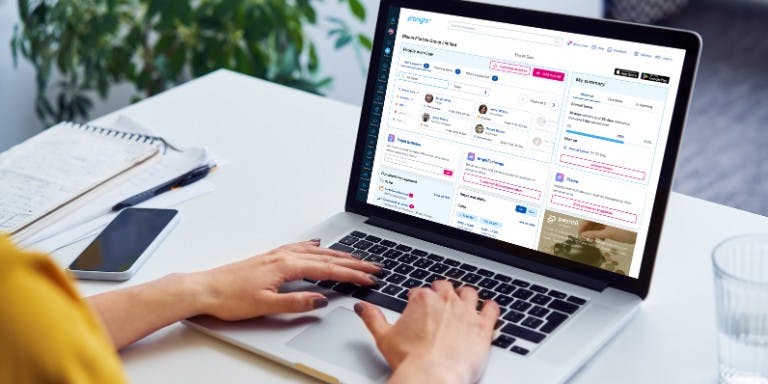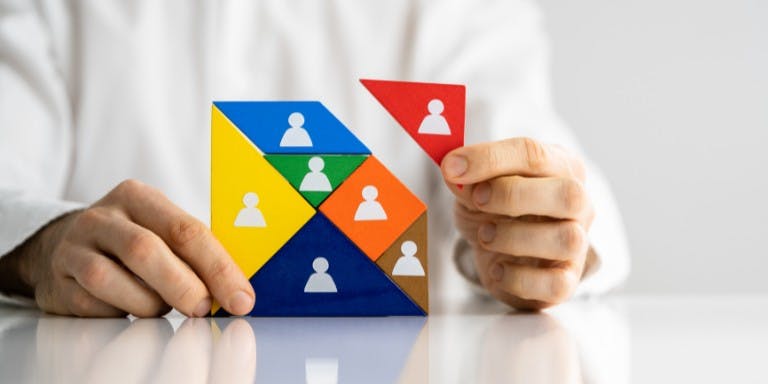First published on Thursday, July 25, 2024
Last updated on Friday, August 16, 2024
Jump to section
When used properly, technology has the potential to enhance workflow efficiencies and increase employee engagement.
It does this by automating routine tasks, providing real-time data for informed decision-making, and fostering a collaborative work environment where employees can easily access and manage their personal details and HR-related information.
As a business owner, you strive to streamline operations and enhance employee experiences, the need for efficient HR management systems has never been more critical. But how do you know which system is right for you and your business?
In this guide, we’ll take a look at the differences between HRIS (Human Resource Information System) and HR software. So, you'll gain a clearer understanding of how each system can meet your business needs and support your HR functions.
The definition of HRIS and HR Software
Before discussing their differences, let's establish clear definitions of HRIS and HR software. This will provide insight into how each technology serves distinct aspects of your HR management:
HRIS (Human Resource Information System)
An HRIS is a comprehensive system designed to manage a wide range of HR functions. These systems primarily focus on storing and organising data related to employees within a company. HRIS supports strategic HR planning, employee data management, and advanced analytics, making it indispensable for large organisations with complex HR needs.
HR Software
HR software comprises of various tools designed to automate and manage day-to-day HR tasks. This includes functions such as shift and roster planning, attendance tracking, and employee self-service portals. Unlike HRIS, which offers a broad scope, HR software solutions are more focused on operational efficiency and are more suited to small and medium-sized businesses.
What are the core features of HRIS?
HRIS systems are powerful tools designed to elevate strategic HR management.
Here are some of the key features and the benefits they bring:
Centralised employee data management
HRIS systems store and manage extensive employee information. Including personal details, employment history, and performance reviews in a centralised database. This ensures seamless accessibility and efficient management of HR data.
Facilitation of strategic HR planning
These systems enable strategic HR planning through robust tools for workforce planning, talent management, and succession planning. They empower HR professionals to align their strategies closely with overarching business objectives.
Advanced reporting and analytics
HRIS systems offer sophisticated reporting and analytics capabilities, allowing organisations to extract actionable insights from HR data. This capability supports informed decision-making, predictive analytics, and proactive HR management practices.
Compliance management
In the dynamic regulatory environment of Australia, HRIS systems play a crucial role in ensuring compliance by automating updates to legal requirements and streamlining compliance-related processes.
What are the core features of HR software?
HR software solutions are dedicated to enhancing operational efficiency and productivity by automating essential HR functions. Here are some of the key features and how they can help:
Streamlined payroll processing
HR software simplifies payroll management with expense calculations, record keeping, and other payroll tasks, ensuring accurate and timely payments.
Attendance and time tracking
These tools facilitate precise monitoring of employee attendance, managing leave requests, and the accurate tracking of working hours to ensure adherence to labour regulations.
Employee self-service
HR software often includes self-service portals empowering employees to update personal information, request time off, and access payslips independently, reducing the administrative burden on your HR team.
Efficient onboarding and offboarding
HR software streamlines the onboarding of new hires and manages the offboarding process for departing employees–ensuring smooth transitions for both your teams and your organisation.
Comprehensive performance management
Many HR software solutions offer features for setting goals, conducting performance reviews, and monitoring employee performance–fostering a culture of continuous improvement and development.
How do these HR technologies benefit Australian businesses?
Implementing HRIS (Human Resource Information System) and HR software offers Australian businesses significant benefits tailored to their specific needs. By leveraging these technologies, organisations can streamline operations, ensure compliance with local employment laws, enhance workforce management, and foster a culture of efficiency and innovation.
This tailored approach not only addresses the complexities of Australian workplace regulations but also empowers businesses to optimise their HR processes effectively.
For large enterprises, HRIS systems are ideal for large companies because of their extensive features and strategic focus. They help manage large amounts of employee data efficiently and support strategic HR initiatives. The advanced analytics and reporting capabilities also provide valuable insights that can help drive business growth.
For small to medium-sized businesses, HR software solutions are more suitable for smaller operations. These tools focus on operational efficiency, digitalising manual tasks, and freeing up time for HR teams and business owners to focus on more strategic business activities. HR software can significantly reduce administrative workload and improve productivity by simplifying payroll, attendance tracking, and allowing for employee self-service.
Compliance with Australian employment laws, both HRIS and HR software help ensure compliance with Australian employment laws and regulations. Features like document templates, access to employment relations advisers, and document storage helps businesses stay updated with legal changes, reducing the risk of non-compliance and associated penalties.
Overall, integrating HRIS and HR software tailored to the specific needs of your Australian business helps you enhance operational efficiency, compliance, and employee satisfaction–positioning your organisation to thrive in a competitive marketplace.
Discover BrightHR’s cloud-based HR software
When choosing the right HR technology you may consider a multitude of factors including your factors including your business size, needs, and strategic goals.
At BrightHR, we understand the diverse needs of Australian businesses. Our HR solutions are designed to cater to both large enterprises and SMEs, providing tailored features that support your HR functions and ensure compliance with notoriously complex Australian laws.
Whether you need a robust HRIS for strategic HR management or a flexible HR software solution to streamline daily operations, BrightHR has got you covered. It’s software and services that are built to help your business grow and grow with your business.
Explore the end-to-end features of BrightHR to see how we can help your business thrive. Or if you want a personalised tour of all the ways our software can support you, book a free HR software demo today.










